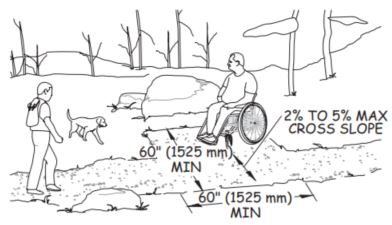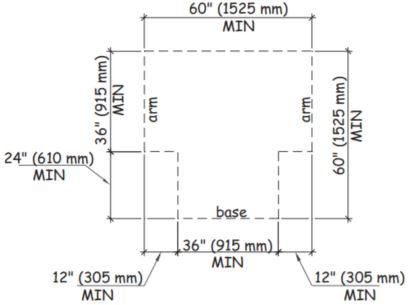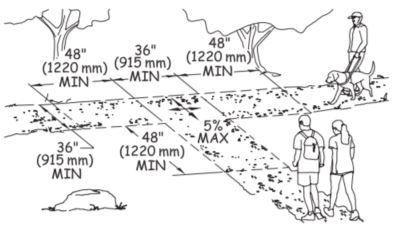Outdoor Developed Areas: A Summary of Accessibility Standards for Federal Outdoor Developed Areas
Passing Spaces [1017.4]
A trail tread width less than 60 inches does not permit two people using mobility devices to pass each other. Consequently, where the tread width is less than 60 inches, passing spaces must be provided at intervals of at least 1000 feet. Where the trail is heavily used or the trail is not at the same level as the adjoining ground surface, such as a bridge crossing a ravine, increasing the frequency of passing spaces or widening the tread width to a minimum of 60 inches provides greater access. People using mobility devices also use passing spaces to turn around.
Where the full length of a trail does not fully comply with the trail technical requirements, a passing space must be located at the end of the trail segment that complies fully with the technical requirements. This enables people who use mobility devices to turn around and proceed back to where they started. Consider ways to alert people using mobility devices when a passing space provides the last opportunity on a trail to turn around, because this may not always be apparent. Printed materials, trail Web sites, trailhead information signs, and signage at the end of the trail segment that fully complies with the technical requirements could be used to indicate the location of the last place on the trail to turn around.
Passing spaces must be:
-
A minimum of 60 by 60 inches (figure 4) or
Figure 4—Minimum dimensions for a passing space.
-
The intersection of two trails that provide a T-shaped space that complies with section 304.3.2 of the ABA Standards (figure 5), and the base and the arms of the T-shaped space extend a minimum of 48 inches beyond the intersection (figure 6)
Figure 5—A T-shaped turning space (304.3.2).
Figure 6—Minimum dimensions for a T-shaped passing space.
Where the intersection of two trails serves as a passing space, the vertical alignment of the trails at the intersection that form the T-shaped space must be nominally planar so that all the wheels of a mobility device remain on the ground when turning into and out of the space. Nominally planar means on the same nominal table surface (same nominal geometric surface plane) and the slopes of the table surface correspond to the running slope and cross slope of the trail tread. For example, if the trail tread has a 2 percent cross slope and 5 percent running slope, the nominal surface plane of the trail tread and passing space must both have a 2 percent cross slope and a 5 percent running slope. This allows people using mobility devices with three or four wheels to better maintain contact with the surface when moving from the main trail into a passing space. This makes it less likely that the mobility device will tip or overbalance to one side.
Passing spaces and resting intervals can overlap. When passing spaces and resting intervals overlap, the technical requirements for resting intervals apply and the slope of the ground surface must be no steeper than 1:48 (2 percent) in any direction. When the surface is constructed of materials other than asphalt, concrete, or boards, slopes no steeper than 1:20 (5 percent) are allowed when necessary for drainage.




User Comments/Questions
Add Comment/Question